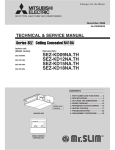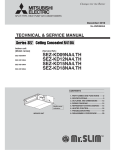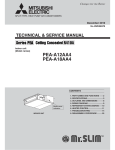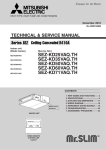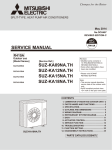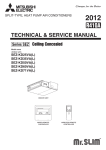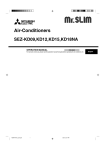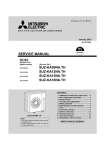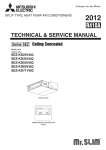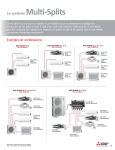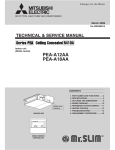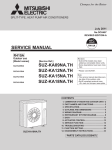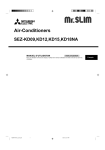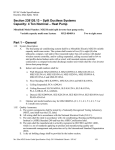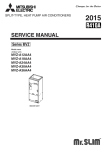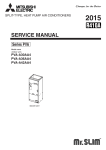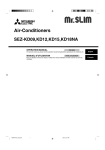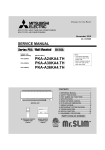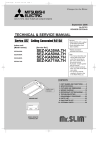Download TECHNICAL & SERVICE MANUAL
Transcript
SPLIT-TYPE, HEAT PUMP AIR CONDITIONERS 2012 TECHNICAL & SERVICE MANUAL Series SEZ Model name <Indoor unit> SEZ-KD09NA(4) SEZ-KD12NA(4) SEZ-KD15NA(4) SEZ-KD18NA(4) INDOOR UNIT TEMP. ON/OFF WIRED REMOTE CONTROLLER CONTENTS 1. PART NAMES AND FUNCTIONS ···········································································2 2. SPECIFICATIONS ···································································································4 3. OUTLINES AND DIMENSIONS·············································································14 4. WIRING DIAGRAM ································································································15 5. REFRIGERANT SYSTEM DIAGRAM····································································17 6. HEATER CONTROL ······························································································18 7. TROUBLESHOOTING ···························································································21 8. DISASSEMBLY PROCEDURE··············································································34 1 PART NAMES AND FUNCTIONS Indoor Unit SEZ-KD09NA(4) SEZ-KD12NA(4) SEZ-KD15NA(4) SEZ-KD18NA(4) Air outlet Air outlet duct flange Air inlet Wired remote controller Once the controls are set, the same operation mode can be repeated by simply pressing the ON/OFF button. ● Operation buttons Start/Stop button Set Temperature buttons Down Fan Speed button Up Timer Menu button (Monitor/Set button) Filter button (<return sign> button) Mode button (Return button) TEMP. ON/OFF Set Time buttons Service button (Clear button) Back Ahead Test Run button MENU BACK MONITOR/SET ON/OFF FILTER DAY CHECK TEST Airflow Up/Down button Timer On/Off button (Set Day button) PAR-21MAA OPERATION CLOCK CLEAR Louver button ( Operation button) To preceding operation number Opening the door Ventilation button Operation button) ( To next operation number 2 ● Display “Sensor” indication Displayed when the remote controller sensor is used. Day-of-Week For purposes of this explanation, all parts of the display are shown as lit. During actual operation, only the relevant items will be lit. Shows the current day of the week. Time/Timer Display “Locked” indicator Shows the current time (The 12 hour clock or The 24 hour clock), unless the simple or Auto Off timer is set. If the simple or Auto Off timer is set, shows the time remaining. Indicates that remote controller buttons have been locked. Identifies the current operation “Clean The Filter” indicator Shows the operating mode, etc. * Multilanguage display is supported. Comes on when it is time to clean the filter. TIME SUN MON TUE WED THU FRI SAT TIMER Hr ON AFTER FUNCTION FILTER ˚F˚C “Centrally Controlled” indicator Indicates that operation of the remote controller has been prohibited by a master controller. Timer indicators AFTER OFF ERROR CODE ˚F˚C The indicator comes on if the corresponding timer is set. WEEKLY SIMPLE AUTO OFF ONLY1Hr. Fan Speed indicator Shows the selected fan speed. “Timer Is Off” indicator Indicates that the timer is off. Temperature Setting Shows the target temperature. Up/Down Air Direction indicator Room Temperature display Shows the room temperature. The indicator shows the direction of the outcoming airflow. Louver display “One Hour Only” indicator Indicates the action of the swing louver. Does not appear if the louver is stationary. Displayed if the airflow is set to Low and downward during COOL or DRY mode. (Operation varies according to model.) The indicator goes off after one hour, at which time the airflow direction also changes. Ventilation indicator Appears when the unit is running in Ventilation mode. (Power On indicator) Indicates that the power is on. Caution ● Only the Power on indicator lights when the unit is stopped and power supplied to the unit. ● If you press a button for a feature that is not installed in the indoor unit, the remote controller will display the “Not Available” message. If you are using the remote controller to operate multiple indoor units, this message will appear only if the feature is not present at the parent unit. ● When power is turned ON for the first time, it is normal that “PLEASE WAIT” is displayed on the room temperature indication (For max. 2minutes). Please wait until this “PLEASE WAIT” indication disappears then start the operation. 3 2 SPECIFICATIONS SEZ-KD09NA(4) Model Name Capacity BTU/h Power source Power input Current Temperature set range Remote controller Airflow direction Fan Type x Quantity External static press Motor type Motor output Driving mechanism Airflow rate(Low-Mid-High) Airflow rate(Low-Mid-High) Airflow rate(Low-Mid-High) External finish External dimension HxWxD Net weight Min.size of wire Wiring Amperage of wire breaker R410A Refrigerant Liquid piping diameter Gas R410A Drain piping diameter Sound level (Low-Mid-High) (measured in anechoic room) Insulation material Air filter Refrigerant control device Protection devices Heat exchanger Varistor Terminal block Power outlet Document Standard Accessory attachment kW A ˚F(˚C) in.WG(Pa) kW m3/min CFM L/S mm In. kg in.(mm) A in.(mm) in.(mm) in.(mm) dB<A> A Cooling 8100 SEZ-KD12NA(4) Heating 10900 208/230V (60Hz) 0.06 0.04 0.51 0.39 67 to 86 (19 to 30) 63 to 83 (17 to 28) Sirocco fan x 2 0.02-0.06-0.14-0.20 (5-15-35-50) DC brushless motor 0.096 Direct-driven 5.5-7.0-9.0 194-247-317 91-116-150 Galvanized 200 x 790 x 700 7-7/8 x 31-1/8 x 27-9/16 18 1/8 (1.6) 15 ø1/4 (ø6.35) Flare ø3/8 (ø9.52) Flare O.D. 1-1/4 (32) Cooling 11500 208/230V (60Hz) 0.07 0.05 0.57 0.46 67 to 86 (19 to 30) 63 to 83 (17 to 28) Sirocco fan x 2 0.02-0.06-0.14-0.20 (5-15-35-50) DC brushless motor 0.096 Direct-driven 7.0-9.0-11.0 247-317-388 116-150-183 Galvanized 200 x 990 x 700 7-7/8 x 39 x 27-9/16 21 1/8 (1.6) 15 ø1/4 (ø6.35) Flare ø3/8 (ø9.52) Flare O.D. 1-1/4 (32) 23-26-30 23-28-33 Polystyrene foam, Polyethylene foam, Urethane foam PP Honeycomb fabric (washable) Fuse (250V 6.3A) Cross fin (Aluminum fin and copper tube) ERZV10D471 To outdoor unit : 3P To wired remote controller : 2P 10 Installation Manual, Instruction Book Polystyrene foam, Polyethylene foam, Urethane foam PP Honeycomb fabric (washable) Fuse (250V 6.3A) Cross fin (Aluminum fin and copper tube) ERZV10D471 To outdoor unit : 3P To wired remote controller : 2P 10 Installation Manual, Instruction Book Drain hose (flexible joint), <Wired Remote Controller> Drain hose (flexible joint), <Wired Remote Controller> Remark Note Heating 13600 1.Cooling/Heating capacity indicates the maximum value at operation under the following condition. Indoor:80˚FD.B. / 67˚FW.B. (26.7˚CD.B. / 19.4˚CW.B.) Outdoor:95˚FD.B. (35˚CD.B.) Indoor:70˚FD.B. (21.1˚CD.B.) Outdoor:47˚FD.B. / 43˚FW.B. (8.3˚CD.B. / 6.1˚CW.B.) Pipe length:24-9/16ft (7.5m) Height difference:0ft (0m) 2.Power consumption. Run current at 0.06[in.WG] (15Pa) (external static pressure) 3.Cooling capacity value at 1:1system Heating capacity value at 1:1system 4. < > SEZ-KD NA only <Cooling> <Heating> 4 SEZ-KD15NA(4) Model Name Capacity BTU/h Power source Power input Current Temperature set range Remote controller Airflow direction Fan Type x Quantity External static press Motor type Motor output Driving mechanism Airflow rate(Low-Mid-High) Airflow rate(Low-Mid-High) Airflow rate(Low-Mid-High) External finish External dimension HxWxD Net weight Min.size of wire Wiring Amperage of wire breaker R410A Refrigerant Liquid piping diameter Gas R410A Drain piping diameter Sound level (Low-Mid-High) (measured in anechoic room) Insulation material Air filter Refrigerant control device Protection devices Heat exchanger Varistor Terminal block Power outlet Document Standard Accessory attachment kW A ˚F(˚C) in.WG(Pa) kW m3/min CFM L/S mm In. kg in.(mm) A in.(mm) in.(mm) in.(mm) dB<A> A Cooling 14100 SEZ-KD18NA(4) Cooling 17200 Heating 18000 208/230V (60Hz) 0.09 0.07 0.74 0.63 67 to 86 (19 to 30) 63 to 83 (17 to 28) Sirocco fan x 3 0.02-0.06-0.14-0.20 (5-15-35-50) DC brushless motor 0.096 Direct-driven 10.0-12.5-15.0 353-441-529 167-208-250 Galvanized 200 x 990 x 700 7-7/8 x 39 x 27-9/16 23 1/8 (1.6) 15 ø1/4 (ø6.35) Flare ø1/2 (ø12.7) Flare O.D. 1-1/4 (32) 208/230V (60Hz) 0.09 0.07 0.74 0.63 67 to 86 (19 to 30) 63 to 83 (17 to 28) Sirocco fan x 4 0.02-0.06-0.14-0.20 (5-15-35-50) DC brushless motor 0.096 Direct-driven 12.0-15.0-18.0 423-529-635 200-250-300 Galvanized 200 x 1190 x 700 7-7/8 x 46-7/8 x 27-9/16 27 1/8 (1.6) 15 ø1/4 (ø6.35) Flare ø1/2 (ø12.7) Flare O.D. 1-1/4 (32) 30-34-37 30-34-38 Polystyrene foam, Polyethylene foam, Urethane foam PP Honeycomb fabric (washable) Fuse (250V 6.3A) Cross fin (Aluminum fin and copper tube) ERZV10D471 To outdoor unit : 3P To wired remote controller : 2P 20 Installation Manual, Instruction Book Polystyrene foam, Polyethylene foam, Urethane foam PP Honeycomb fabric (washable) Fuse (250V 6.3A) Cross fin (Aluminum fin and copper tube) ERZV10D471 To outdoor unit : 3P To wired remote controller : 2P 20 Installation Manual, Instruction Book Drain hose (flexible joint), <Wired Remote Controller> Drain hose (flexible joint), <Wired Remote Controller> Remark Note Heating 21600 1.Cooling/Heating capacity indicates the maximum value at operation under the following condition. Indoor:80˚FD.B. / 67˚FW.B. (26.7˚CD.B. / 19.4˚CW.B.) Outdoor:95˚FD.B. (35˚CD.B.) Indoor:70˚FD.B. (21.1˚CD.B.) Outdoor:47˚FD.B. / 43˚FW.B. (8.3˚CD.B. / 6.1˚CW.B.) Pipe length:24-9/16ft (7.5m) Height difference:0ft (0m) 2.Power consumption. Run current at 0.06[in.WG] (15Pa) (external static pressure) 3.Cooling capacity value at 1:1system Heating capacity value at 1:1system 4. < > SEZ-KD NA only <Cooling> <Heating> 5 SOUND CRITERION CURVES <60Hz> SEZ-KD09NA(4) NOTCH SPL(dB) High 29 Middle 25 Low 22 External static pressure: 0.02[in.WG](5Pa) LINE NC-70 60 NC-60 50 NC-50 40 NC-40 30 NC-30 APPROXIMATE TERESHOLD OF HEARING FOR CONTINUOUS NOISE NC-20 OCTAVE BAND SOUND PRESSURE LEVEL, dB (0 dB = 0.0002 µbar) OCTAVE BAND SOUND PRESSURE LEVEL, dB (0 dB = 0.0002 µbar) 70 10 80 70 NC-70 60 NC-60 50 NC-50 40 NC-40 30 NC-30 20 APPROXIMATE TERESHOLD OF HEARING FOR CONTINUOUS NOISE NC-20 10 63 125 250 500 1000 2000 4000 8000 63 125 BAND CENTER FREQUENCIES, Hz NOTCH SPL(dB) High 31 Middle 28 Low 24 External static pressure: 0.14[in.WG](35Pa) 250 500 1000 2000 4000 8000 BAND CENTER FREQUENCIES, Hz <60Hz> SEZ-KD09NA(4) LINE <60Hz> SEZ-KD09NA(4) NOTCH SPL(dB) High 33 Middle 29 Low 25 External static pressure: 0.20[in.WG](50Pa) LINE 90 80 70 NC-70 60 NC-60 50 NC-50 40 NC-40 30 NC-30 APPROXIMATE TERESHOLD OF HEARING FOR CONTINUOUS NOISE NC-20 OCTAVE BAND SOUND PRESSURE LEVEL, dB (0 dB = 0.0002 µbar) 90 OCTAVE BAND SOUND PRESSURE LEVEL, dB (0 dB = 0.0002 µbar) LINE 90 80 20 NOTCH SPL(dB) High 30 Middle 26 Low 23 External static pressure: 0.06[in.WG](15Pa) 90 20 <60Hz> SEZ-KD09NA(4) 10 80 70 NC-70 60 NC-60 50 NC-50 40 NC-40 30 NC-30 20 APPROXIMATE TERESHOLD OF HEARING FOR CONTINUOUS NOISE NC-20 10 63 125 250 500 1000 2000 4000 8000 63 BAND CENTER FREQUENCIES, Hz 125 250 500 1000 2000 4000 8000 BAND CENTER FREQUENCIES, Hz NOTE: The sound level is measured in an anechoic room where echoes are few, when compressor stops. The sound may be bigger than displayed level under actual installation condition by surrounding echoes. The sound level can be higher by about 2 dB than the displayed level during cooling and heating operation. 6 <60Hz> SEZ-KD12NA(4) NOTCH SPL(dB) High 33 Middle 28 Low 23 External static pressure: 0.02[in.WG](5Pa) LINE NC-70 60 NC-60 50 NC-50 40 NC-40 30 NC-30 APPROXIMATE TERESHOLD OF HEARING FOR CONTINUOUS NOISE NC-20 OCTAVE BAND SOUND PRESSURE LEVEL, dB (0 dB = 0.0002 µbar) OCTAVE BAND SOUND PRESSURE LEVEL, dB (0 dB = 0.0002 µbar) 70 10 80 70 NC-70 60 NC-60 50 NC-50 40 NC-40 30 NC-30 20 APPROXIMATE TERESHOLD OF HEARING FOR CONTINUOUS NOISE NC-20 10 63 125 250 500 1000 2000 4000 8000 63 125 BAND CENTER FREQUENCIES, Hz NOTCH SPL(dB) High 34 Middle 29 Low 24 External static pressure: 0.14[in.WG](35Pa) 250 500 1000 2000 4000 8000 BAND CENTER FREQUENCIES, Hz <60Hz> SEZ-KD12NA(4) LINE <60Hz> SEZ-KD12NA(4) NOTCH SPL(dB) High 35 Middle 31 Low 25 External static pressure: 0.20[in.WG](50Pa) LINE 90 80 70 NC-70 60 NC-60 50 NC-50 40 NC-40 30 NC-30 APPROXIMATE TERESHOLD OF HEARING FOR CONTINUOUS NOISE NC-20 10 OCTAVE BAND SOUND PRESSURE LEVEL, dB (0 dB = 0.0002 µbar) 90 OCTAVE BAND SOUND PRESSURE LEVEL, dB (0 dB = 0.0002 µbar) LINE 90 80 20 NOTCH SPL(dB) High 33 Middle 28 Low 23 External static pressure: 0.06[in.WG](15Pa) 90 20 <60Hz> SEZ-KD12NA(4) 80 70 NC-70 60 NC-60 50 NC-50 40 NC-40 30 NC-30 20 APPROXIMATE TERESHOLD OF HEARING FOR CONTINUOUS NOISE NC-20 10 63 125 250 500 1000 2000 4000 8000 63 BAND CENTER FREQUENCIES, Hz 125 250 500 1000 2000 4000 8000 BAND CENTER FREQUENCIES, Hz NOTE: The sound level is measured in an anechoic room where echoes are few, when compressor stops. The sound may be bigger than displayed level under actual installation condition by surrounding echoes. The sound level can be higher by about 2 dB than the displayed level during cooling and heating operation. 7 <60Hz> SEZ-KD15NA(4) NOTCH SPL(dB) High 36 Middle 33 Low 29 External static pressure: 0.02[in.WG](5Pa) LINE NC-70 60 NC-60 50 NC-50 40 NC-40 30 NC-30 APPROXIMATE TERESHOLD OF HEARING FOR CONTINUOUS NOISE NC-20 OCTAVE BAND SOUND PRESSURE LEVEL, dB (0 dB = 0.0002 µbar) OCTAVE BAND SOUND PRESSURE LEVEL, dB (0 dB = 0.0002 µbar) 70 10 80 70 NC-70 60 NC-60 50 NC-50 40 NC-40 30 NC-30 20 APPROXIMATE TERESHOLD OF HEARING FOR CONTINUOUS NOISE NC-20 10 63 125 250 500 1000 2000 4000 8000 63 125 BAND CENTER FREQUENCIES, Hz NOTCH SPL(dB) High 38 Middle 35 Low 31 External static pressure: 0.14[in.WG](35Pa) 250 500 1000 2000 4000 8000 BAND CENTER FREQUENCIES, Hz <60Hz> SEZ-KD15NA(4) LINE <60Hz> SEZ-KD15NA(4) NOTCH SPL(dB) High 39 Middle 36 Low 32 External static pressure: 0.20[in.WG](50Pa) LINE 90 80 70 NC-70 60 NC-60 50 NC-50 40 NC-40 30 NC-30 APPROXIMATE TERESHOLD OF HEARING FOR CONTINUOUS NOISE NC-20 OCTAVE BAND SOUND PRESSURE LEVEL, dB (0 dB = 0.0002 µbar) 90 OCTAVE BAND SOUND PRESSURE LEVEL, dB (0 dB = 0.0002 µbar) LINE 90 80 20 NOTCH SPL(dB) High 37 Middle 34 Low 30 External static pressure: 0.06[in.WG](15Pa) 90 20 <60Hz> SEZ-KD15NA(4) 10 80 70 NC-70 60 NC-60 50 NC-50 40 NC-40 30 NC-30 20 APPROXIMATE TERESHOLD OF HEARING FOR CONTINUOUS NOISE NC-20 10 63 125 250 500 1000 2000 4000 8000 63 BAND CENTER FREQUENCIES, Hz 125 250 500 1000 2000 4000 8000 BAND CENTER FREQUENCIES, Hz NOTE: The sound level is measured in an anechoic room where echoes are few, when compressor stops. The sound may be bigger than displayed level under actual installation condition by surrounding echoes. The sound level can be higher by about 2 dB than the displayed level during cooling and heating operation. 8 <60Hz> SEZ-KD18NA(4) NOTCH SPL(dB) High 37 Middle 33 Low 29 External static pressure: 0.02[in.WG](5Pa) LINE NC-70 60 NC-60 50 NC-50 40 NC-40 30 NC-30 APPROXIMATE TERESHOLD OF HEARING FOR CONTINUOUS NOISE NC-20 OCTAVE BAND SOUND PRESSURE LEVEL, dB (0 dB = 0.0002 µbar) OCTAVE BAND SOUND PRESSURE LEVEL, dB (0 dB = 0.0002 µbar) 70 10 80 70 NC-70 60 NC-60 50 NC-50 40 NC-40 30 NC-30 20 APPROXIMATE TERESHOLD OF HEARING FOR CONTINUOUS NOISE NC-20 10 63 125 250 500 1000 2000 4000 8000 63 125 BAND CENTER FREQUENCIES, Hz NOTCH SPL(dB) High 39 Middle 35 Low 31 External static pressure: 0.14[in.WG](35Pa) 250 500 1000 2000 4000 8000 BAND CENTER FREQUENCIES, Hz <60Hz> SEZ-KD18NA(4) LINE <60Hz> SEZ-KD18NA(4) NOTCH SPL(dB) High 39 Middle 36 Low 32 External static pressure: 0.20[in.WG](50Pa) LINE 90 80 70 NC-70 60 NC-60 50 NC-50 40 NC-40 30 NC-30 APPROXIMATE TERESHOLD OF HEARING FOR CONTINUOUS NOISE NC-20 10 OCTAVE BAND SOUND PRESSURE LEVEL, dB (0 dB = 0.0002 µbar) 90 OCTAVE BAND SOUND PRESSURE LEVEL, dB (0 dB = 0.0002 µbar) LINE 90 80 20 NOTCH SPL(dB) High 38 Middle 34 Low 30 External static pressure: 0.06[in.WG](15Pa) 90 20 <60Hz> SEZ-KD18NA(4) 80 70 NC-70 60 NC-60 50 NC-50 40 NC-40 30 NC-30 20 APPROXIMATE TERESHOLD OF HEARING FOR CONTINUOUS NOISE NC-20 10 63 125 250 500 1000 2000 4000 8000 63 BAND CENTER FREQUENCIES, Hz 125 250 500 1000 2000 4000 8000 BAND CENTER FREQUENCIES, Hz NOTE: The sound level is measured in an anechoic room where echoes are few, when compressor stops. The sound may be bigger than displayed level under actual installation condition by surrounding echoes. The sound level can be higher by about 2 dB than the displayed level during cooling and heating operation. 9 INDOOR FAN PERFORMANCE AND CORRECTED AIR FLOW SEZ-KD09NA(4) SEZ-KD09NA(4) (External static pressure 0.06[in.WG](15Pa)) 208/230V 60Hz (External static pressure 0.02[in.WG](5Pa)) 208/230V 60Hz 40 [0.16] 50 [0.20] Limit External static pressure [in.WG](Pa) External static pressure [in.WG](Pa) Limit 30 [0.12] 20 [0.08] High 40 [0.16] High 30 [0.12] 20 [0.08] Middle Rated point 10 [0.04] Middle 10 [0.04] Low Low Rated point 0 0 4 [141] 5 [176] 6 7 8 [212] [247] [282] 3 Airflow rate(m /min)[CFM] 9 [318] 4 [141] 10 [353] SEZ-KD09NA(4) 5 [176] 6 7 8 [212] [247] [282] 3 Airflow rate(m /min)[CFM] 10 [353] SEZ-KD09NA(4) (External static pressure 0.14[in.WG](35Pa)) 208/230V 60Hz (External static pressure 0.20[in.WG](50Pa)) 208/230V 60Hz 80 [0.32] 80 [0.32] Limit Limit 70 [0.28] External static pressure [in.WG](Pa) External static pressure [in.WG](Pa) 9 [318] 60 [0.24] 50 [0.20] High 40 [0.16] Rated point 30 [0.12] Middle 20 [0.08] 70 [0.28] High 60 [0.24] 50 [0.20] Rated point 40 [0.16] Middle 30 [0.12] Low 20 [0.08] Low 10 [0.04] 10 [0.04] 0 4 [141] 0 5 [176] 6 7 8 [212] [247] [282] 3 Airflow rate(m /min)[CFM] 9 [318] 10 [353] 4 [141] 10 5 [176] 6 7 8 [212] [247] [282] 3 Airflow rate(m /min)[CFM] 9 [318] 10 [353] SEZ-KD12NA(4) SEZ-KD12NA(4) (External static pressure 0.02[in.WG](5Pa)) 208/230V 60Hz (External static pressure 0.06[in.WG](15Pa)) 208/230V 60Hz 50 [0.20] External static pressure [in.WG](Pa) External static pressure [in.WG](Pa) 40 [0.16] 30 [0.12] Limit 20 [0.08] High 40 [0.16] Limit 30 [0.12] High 20 [0.08] Middle Rated point 10 [0.04] Middle 10 [0.04] Rated point Low Low 0 6 [212] 0 7 [247] 8 9 10 [282] [318] [353] 3 Airflow rate(m /min)[CFM] 11 [388] 12 [424] SEZ-KD12NA(4) 6 [212] 7 [247] 8 9 10 [282] [318] [353] 3 Airflow rate(m /min)[CFM] 11 [388] 12 [424] SEZ-KD12NA(4) (External static pressure 0.14[in.WG](35Pa)) 208/230V 60Hz (External static pressure 0.20[in.WG](50Pa)) 208/230V 60Hz 80 [0.32] 80 [0.32] 70 [0.28] 70 [0.28] 60 [0.24] External static pressure [in.WG](Pa) External static pressure [in.WG](Pa) Limit Limit 50 [0.20] 40 [0.16] Rated point 30 [0.12] High Middle 20 [0.08] 50 [0.20] Rated point High 40 [0.16] Middle 30 [0.12] 20 [0.08] Low Low 10 [0.04] 10 [0.04] 0 6 [212] 60 [0.24] 0 7 [247] 8 9 10 [282] [318] [353] 3 Airflow rate(m /min)[CFM] 11 [388] 12 [424] 11 6 [212] 7 [247] 8 9 10 [282] [318] [353] Airflow rate(m3/min)[CFM] 11 [388] 12 [424] SEZ-KD15NA(4) SEZ-KD15NA(4) (External static pressure 0.02[in.WG](5Pa)) 208/230V 60Hz (External static pressure 0.06[in.WG](15Pa)) 208/230V 60Hz 50 [0.20] Limit External static pressure [in.WG](Pa) External static pressure [in.WG](Pa) 40 [0.16] 30 [0.12] 20 [0.08] High Middle Limit 40 [0.16] 30 [0.12] High 20 [0.08] Middle Rated point Low 10 [0.04] 10 [0.04] Low Rated point 0 8 [282] 0 9 [318] 10 [353] 11 12 13 14 [388] [424] [459] [494] 3 Airflow rate(m /min)[CFM] 15 [530] 16 [565] SEZ-KD15NA(4) 70 [0.28] 70 [0.28] External static pressure [in.WG](Pa) 80 [0.32] Limit 60 [0.24] 50 [0.20] High 40 [0.16] Middle 30 [0.12] Rated point 11 12 13 14 [388] [424] [459] [494] 3 Airflow rate(m /min)[CFM] 15 [530] 16 [565] Limit High 60 [0.24] 50 [0.20] Rated point Middle 40 [0.16] 30 [0.12] Low 20 [0.08] Low 10 [0.04] 10 [0.04] 0 8 [282] 10 [353] (External static pressure 0.20[in.WG](50Pa)) 208/230V 60Hz 80 [0.32] 20 [0.08] 9 [318] SEZ-KD15NA(4) (External static pressure 0.14[in.WG](35Pa)) 208/230V 60Hz External static pressure [in.WG](Pa) 8 [282] 0 9 [318] 10 [353] 11 12 13 14 [388] [424] [459] [494] 3 Airflow rate(m /min)[CFM] 15 [530] 16 [565] 8 [282] 12 9 [318] 10 [353] 11 12 13 14 [388] [424] [459] [494] 3 Airflow rate(m /min)[CFM] 15 [530] 16 [565] SEZ-KD18NA(4) SEZ-KD18NA(4) (External static pressure 0.02[in.WG](5Pa)) 208/230V 60Hz (External static pressure 0.06[in.WG](15Pa)) 208/230V 60Hz 40 [0.16] 50 [0.20] Limit External static pressure [in.WG](Pa) External static pressure [in.WG](Pa) Limit 30 [0.12] 20 [0.08] High Middle 10 [0.04] High 30 [0.12] Middle 20 [0.08] Low Rated point 10 [0.04] Low Rated point 0 9 [318] 40 [0.16] 0 10 11 [353] [388] 12 [424] 13 14 15 16 17 18 19 [459] [494] [530] [565] [600] [636] [671] 9 [318] 10 11 [353] [388] 12 [424] 3 13 14 15 16 17 18 19 [459] [494] [530] [565] [600] [636] [671] Airflow rate(m3/min)[CFM] Airflow rate(m /min)[CFM] SEZ-KD18NA(4) SEZ-KD18NA(4) (External static pressure 0.14[in.WG](35Pa)) 208/230V 60Hz (External static pressure 0.20[in.WG](50Pa)) 208/230V 60Hz 80 [0.32] 80 [0.32] Limit External static pressure [in.WG](Pa) External static pressure [in.WG](Pa) Limit 70 [0.28] 60 [0.24] High 50 [0.20] 40 [0.16] Middle Rated point 30 [0.12] Low 70 [0.28] 50 [0.20] Rated point 30 [0.12] 20 [0.08] 10 [0.04] 10 [0.04] 9 [318] Middle 40 [0.16] 20 [0.08] 0 High 60 [0.24] Low 0 10 11 [353] [388] 12 [424] 13 14 15 16 17 18 19 [459] [494] [530] [565] [600] [636] [671] 3 9 [318] 10 11 [353] [388] 12 [424] 13 14 15 16 17 18 19 [459] [494] [530] [565] [600] [636] [671] Airflow rate(m3/min)[CFM] Airflow rate(m /min)[CFM] 13 3 OUTLINES AND DIMENSIONS SEZ-KD09NA(4) SEZ-KD12NA(4) SEZ-KD15NA(4) SEZ-KD18NA(4) Unit : mm(in.) Drain pipe(O.D.ø32(1-1/4)) (Emergency draining) 159(6-9/32) 345(13-19/32) Suspension bolt hole 4-14X30(9/16X1-3/16) Slot 25(1) Control box 116 (4-19/32) 70 (2-25/32) 270(10-21/32) 2X2-ø2.9(1/8) 1 Refrigerant piping flare connection (gas) 100(3-15/16)XJ=K 100(3-15/16) 88(3-15/32) 20(13/16) Knockout hole ø27(1-3/32) (Remote controller transmission line) Terminal block (Indoor/outdoor connecting line) Refrigerant piping flare connection (liquid) 2 Air filter Knockout hole ø27(1-3/32) (Indoor/outdoor connecting line) 102(4-1/32) 170(6-23/32) 200(7-7/8) 700(27-9/16) 677(26-21/32) 23(29/32) 10(13/32) 100 (3-15/16) 150(Duct) (5-29/32) 23(29/32) Drain pipe(O.D.ø32(1-1/4)) 23(29/32) 57(2-1/4) 49 (1-15/16) 90 (3-9/16) 25(1) 20(13/16) 30(1-3/16) 10(13/32) 625(Suspension bolt pitch) (24-5/8) 12(1/2) Air inlet 57(2-1/4) Air outlet H A L-ø2.9(1/8) N B (Suspension bolt pitch) C M D (Duct) 100(3-15/16)X(E-1)=F 100(3-15/16) 2XE-ø2.9(1/8) 20(13/16) 12(1/2) 88(3-15/32) 15(19/32) 37(1-15/32) 100(3-15/16) 157.5 (6-7/32) 37(1-15/32) Terminal block (Remote controller transmission line) Drain pipe(O.D.ø32(1-1/4)) (Spontaneous draining) ) 7 77 9/32 -1 Access (30 Note2 50 (1 G -31/3 175±5(6-29/32±7/32) (Actual length) Less than 550 (21-21/32) 2) 1/3 3 (150 door 2) (1- 0 45 2) 00 3/3 an 3 /16) 2 3 th (17 ore 11-1 ( M 31 /32 50 ~ ~ 5 150 -29 /32 ) (17 450 -23 /32 More than 10 (13/32) More than 20 (13/16) Less than 300 (11-13/16) Ceiling surface Access door Make the access door at the appointed position properly for service maintenance. Drain hose (I.D.ø32(1-1/4)) <accessory> ) Required space for service and maintenance mm(in.) Model A B 700 752 SEZ-KD09NA(4) (27-9/16) (29-5/8) SEZ-KD12NA(4) 900 952 (35-7/16) (37-1/2) SEZ-KD15NA(4) C D E 798 660 7 (23-5/8) (31-1/2) 998 860 9 (31-1/2) (39-3/8) (33-7/8) (31-7/16) (26) (39-5/16) (33-7/8) 1100 1152 1198 1060 SEZ-KD18NA(4) (43-5/16) (45-3/8) (47-3/16) (41-3/4) 11 F G H J K L 600 800 660 5 (19-11/16) 500 16 800 1000 860 7 (27-9/16) 700 1039 990 20 (40-29/32) (39) (26) 1000 1200 1060 (39-3/8) (47-1/4) (41-3/4) 9 900 (35-7/16) M N 839 790 (33-1/16) (31-1/8) 1239 1190 24 (48-25/32) (46-7/8) Note1.Use M10 screw for the suspension bolt (field supply). 2.Keep the service space for the maintenance at the bottom. 3.This chart indicates for SEZ-KD15NA(4) model, which has 3 fans. SEZ-KD09,12NA(4) models have 2 fans. SEZ-KD18NA(4) models have 4 fans. 4.In case an inlet duct is used, remove the air filter (supply with the unit), then install the filter (field supply) at suction side. 14 1 Gas pipe 2 Liquid pipe ø9.52(3/8) ø6.35(1/4) ø12.7(1/2) 4 WIRING DIAGRAM SEZ-KD09NA SEZ-KD12NA SEZ-KD15NA SEZ-KD18NA INSIDE SECTION OF CONTROL BOX TO MA REMOTE CONTROLLER TB15 1 2 I. B. SW1 SW2 CN2L 1 CN24 (Yellow) CN51 CN32 12 CN22 (Blue) ON OFF 1 3 5 3 1 CNP (Blue) DSA CN41 SWE ZNR02 U DC310~340V Rectify circuit ZNR01 FUSE U LED2 LED3 CN90 CN01 (Black) 3 CN3C (Blue) LED1 CN4F 1234 CN44 1234 CN20 (Red) 12 X1 CNMF 7654 1 TB4 S1 S2 TO OUTDOOR UNIT S3 t° FS t° t° TH2 TH5 M TH1 M 1~ Drainpump Fan motor SYMBOL EXPLANATION SYMBOL NAME INDOOR CONTROLLER BOARD FUSE FUSE AC250V 6.3A LED3 TRANSMISSION (INDOOR-OUTDOOR) ZNR01,02 VARISTOR SW1 SWITCH (FOR MODEL SELECTION) DSA ARRESTER SW2 SWITCH (FOR CAPACITY CODE) X1 AUX. RELAY SWE CONNECTOR (EMERGENCY OPERATION) CN2L CONNECTOR (LOSSNAY) TH1 INTAKE AIR TEMP. THERMISTOR CN24 CONNECTOR (BACK-UP HEATING) TH2 PIPE TEMP. THERMISTOR/LIQUID CN32 CONNECTOR (REMOTE SWITCH) TH5 COND./EVA. TEMP. THERMISTOR CN41 CONNECTOR (HA TERMINAL-A) FS CN51 CONNECTOR (CENTRALLY CONTROL) TB4 CN90 CONNECTOR (WIRELESS) FLOAT SWITCH TERMINAL BLOCK (INDOOR/OUTDOOR CONNECTING LINE) TERMINAL BLOCK (REMOTE CONTROLLER TRANSMISSION LINE) I. B. LED1 POWER SUPPLY (I.B.) SYMBOL LED2 TB15 NAME POWER SUPPLY (I.B.) Note1.Since the outdoor side electric wiring may change be sure to check the outdoor unit electric wiring for servicing. 2.Indoor and outdoor connecting wires are made with polarities, make wiring matching terminal numbers(S1,S2,S3). 3.Symbols used in wiring diagram above are, :Connector, :Terminal. 4.Use copper supply wire. 15 CONTROL BOX TB15 I. B. TB4 PARTS LOCATION SEZ-KD09NA4 SEZ-KD12NA4 SEZ-KD15NA4 SEZ-KD18NA4 INSIDE SECTION OF CONTROL BOX 2 I. B. SW1 SW2 (RED) CN2L ON OFF SWE LED3 (WHITE) CN90 (RED) CN105 1 1 2 TB15 9 2 TB6 FUSE TB4 (WHITE) CN44 1 4 (RED) LED1 (WHITE) CN20 CN30(GREEN) CNMF 7 4 12 X1 1 S1 S2 1 CNP (BLUE) 3 TO OUTDOOR UNIT S3 5 TRANSMISSION WIRES DC 12V 1 5 LED2 (WHITE) CN4F 4 1 5 1 9 CN01 (BLACK) 1 3 1 3 SW6 CN3C (BLUE) 1 2 ON DC294-340V OFF 1 2 RECTIFY CIRCUIT CN22 (BLUE) + - CN32 CN24 (YELLOW) CN41 CN51 RFI 1 CONTROL BOX 9 CN1 BZ1 LED1 RU FS TH2 TH5 MS 3~ TH1 I. B. M 1~ DRAINPUMP FAN MOTOR R.B. SW1 SW2 W.B. TB15 TB4 PARTS LOCATION SYMBOL EXPLANATION SYMBOL NAME INDOOR CONTROLLER BOARD I.B. SYMBOL NAME INDOOR CONTROLLER BOARD I.B. SYMBOL NAME OPTIONAL PARTS FUSE FUSE AC250V 6.3A SW1 SWITCH (FOR MODEL SELECTION) X1 AUX. RELAY SW2 SWITCH (FOR CAPACITY CODE) RU RECEIVING UNIT CN2L CONNECTOR (LOSSNAY) SW6 SWITCH (FOR EMERGENCY OPERATION)) BZ1 BUZZER CN24 CONNECTOR (BACK-UP HEATING) SWE CONNECTOR (EMERGENCY OPERATION) LED1 LED (RUN INDICATOR) CN30 CONNECTOR (LLC) TH1 INTAKE AIR TEMP. THERMISTOR SW1 SWITCH (HEATING ON/OFF) CN32 CONNECTOR (REMOTE SWITCH) TH2 PIPE TEMP. THERMISTOR/LIQUID SW2 SWITCH (COOLING ON/OFF) CN41 CONNECTOR (HA TERMINAL-A) TH5 COND./EVA. TEMP. THERMISTOR CN51 CONNECTOR (CENTRALLY CONTROL) FS FLOAT SWITCH CN90 CONNECTOR (WIRELESS) TB4 TERMINAL BLOCK (INDOOR/OUTDOOR CONNECTING LINE) TB15 TERMINAL BLOCK (REMOTE CONTROLLER TRANSMISSION LINE) RFI RADIO FREQUENCY INTERFACE FOR RF THERMOSTAT CN105 CONNECTOR (RADIO FREQUENCY INTERFACE) LED1 POWER SUPPLY (I.B.) LED2 POWER SUPPLY (I.B.) LED3 TRANSMISSION (INDOOR-OUTDOOR) Note1. Since the outdoor side electric wiring may change be sure to check the outdoor unit electric wiring for servicing. 2. Indoor and outdoor connecting wires are made with polarities,make wiring matchingterminal numbers (S1,S2,S3). 3. Symbols used in wiring diagram above are as follows. :CONNECTOR :TERMINAL (HEAVY DOTTED LINE):FIELD WIRING (THIN DOTTED LINE):OPTIONAL PARTS 4. Use copper supply wire. 16 W.B. R.B. TB6 IR WIRELESS REMOTE CONTROLLER BOARD REMOTE CONTROLLER BOARD TERMINAL BLOCK (REMOTE CONTROLLER TRANSMISSION LINE) 5 REFRIGERANT SYSTEM DIAGRAM SEZ-KD09NA(4) SEZ-KD12NA(4) SEZ-KD15NA(4) SEZ-KD18NA(4) Strainer #50 Heat exchanger Refrigerant GAS pipe connection (Flare) Condenser/evaporator temperature thermistor (TH5) Refrigerant flow in cooling Refrigerant flow in heating Refrigerant LIQUID pipe connection (Flare) Pipe temperature thermistor/liquid (TH2) Room temperature thermistor (TH1) Distributor Strainer #50 17 6 HEATER CONTROL 6-1. Control specifications and Function setting Table 1 shows how the field-installed heater is controlled. Select the desired pattern in the table below, and set the Function on the indoor units as shown in Table 1. Table.1 [Function table] Select unit numbers 01 to 03 or all units (AL[wired remote controller] / 07[wireless remote controller]) Mode Heater control Setting Mode no. Setting Initial setting Heater OFF Inlet air temp. set temp. Heater ON Inlet air temp. < set temp.-4.5˚F(2.5˚C) The fan will stop and the heater will turn off when [DEFROST] or [ERROR] is displayed. 23 1 23 2 Set temp. Set temp.-1.8˚F(1˚C) Set temp.-4.5 ˚F(2.5˚C) Inlet air temp. ON OFF Heater output Heater OFF Inlet air temp. set temp. Heater ON Inlet air temp. < set temp.-1.8˚F(2.5˚C) The fan will drive and the heater will turn on when [DEFROST] or [ERROR] is displayed. - Set temp. Set temp.-1.8˚F(2.5˚C) Inlet air temp. ON OFF Heater output *Refer to the Installation Manual for function settings. 6-2. Fan control By setting the Mode No. 23 in the Function Table in section 6-1 and using CN4Y on the optional parts PAC-YU25HT, the following patterns of fan control will become possible when [DEFROST] or [ERROR] is displayed. Fan control patterns when [DEFROST] or [ERROR] is displayed Use of CN4Y (PAC-YU25HT) Heater is off. Heater is installed in the duct. Unused* No heater is installed in the duct. Used Fan ON*1 Fan OFF Fan ON*1 Fan OFF Heater is on. * If a heater is installed in the duct, do not use CN4Y. By doing so, the fan will turn off when the heater is on, which may result in fire. *1 Fan speed setting Mode Fan control Setting Heating Thermo-OFF Very low [DEFROST] or [ERROR] Very low STOP Remote controller setting Remote controller setting Remote controller setting *Refer to the Installation Manual for function settings. 18 Initial setting Mode no. Setting 25 1 25 2 - 25 3 - 6-3. PAC-YU25HT (Optional Parts) installation The following section describes installation of the External Heater Adapter that connects to SEZ-KD NA series indoor unit. This products is the special wiring parts to drive an electric heater with the air conditioner. (1) Parts list Check that the following parts are included in the package. 1) External output cable (with a yellow connector).............................2 in total Two types of cables with different connectors are included. 2) Panel heater connector.................................................................. 3 in total White: 1 Green: 2 (2 types) (2) Connection to the indoor unit Use the cables that fit the connectors on the indoor unit control board. 1) External output cable (with a yellow connector) This cable is used to connect a relay circuit for an interlocked operation with either an electric or a panel heater. Connect the cable to CN24 on the indoor unit control board. 2) Panel heater connector (with a white connector) This connector is used to perform an interlocked operation with a panel heater. Depending on the indoor unit control board specification, connect the cable to CN4Y as appropriate <Image> CN4Y for FAN control (PAC-YU25HT) (3) Locally procured wiring A basic connection method is shown below. Electric Heater power source Remote control board Relay circuit Indoor unit control board Adapter White 2 White 1 X X Electric Heater or panel heater 3 (applicable only when a panel heater is connected) CN4Y White 1 Yellow CN24 Red Maximum cable length is 10 m (32ft) Preparations in the field 19 For relay X, use the specifications given below. Rated voltage: 12VDC Power consumption: 0.9W or less * Use the diode that is recommended by the relay manufacturer at both ends of the relay coil. The length of the electrical wiring for the PAC-YU25HT is 2 meters (6-1/2 ft.) To extend this length, use sheathed 2-core cable. Control cable type: CVV, CVS, CPEV or equivalent. Cable size: 0.5 mm2 ~ 1.25 mm2 (16 to 22 AWG) Don't extend the cable more than 10 meters (32ft) Recommended circuit FS1 H1 88H FS2 FS1 H2 88H FS2 R Wiring diagram 1-phase power supply S 208V, 230V/60Hz R S FS1, 2 ----- Thermal fuse 26H 88H Control board H1, H2 ----- Heater 26H --------- Overheat protection thermostat 88H --------- Electromagnetic contactor CN24 (4) Wiring restrictions Keep the length of the cable connecting to the circuit board of the indoor unit shorter than 10 meters (32ft). Longer than 10 meters (32ft) could cause improper operation. Use a transit relay when extending wiring such as remote wiring. 20 7 TROUBLESHOOTING 7-1. CAUTIONS ON TROUBLESHOOTING (1) Before troubleshooting, check the followings: 1 Check the power supply voltage. 2 Check the indoor/outdoor connecting wire for mis-wiring. (2) Take care the followings during servicing. 1 Before servicing the air conditioner, be sure to turn off the remote controller first to stop the main unit, and then turn off the breaker. 2 When removing the indoor controller board, hold the edge of the board with care NOT to apply stress on the components. 3 When connecting or disconnecting the connectors, hold the housing of the connector. DO NOT pull the lead wires. Lead wires 7-2. SELF-CHECK FUNCTION Wired remote controller (1) Turn on the power. (2) Press the [CHECK] button twice. (3) Set refrigerant address with [TEMP] button if system control is used. (4) Press the [ON/OFF] button to stop the self-check. A CHECK button B Indoor Unit’s Refrigerant address C TEMP button D IC : Indoor unit OC : Outdoor unit E Check code F Indoor Unit No. B EDF ERROR CODE TEMP. C MENU BACK PAR-21MAA MONITOR/SET ON/OFF ON/OFF FILTER DAY CLOCK CHECK TEST OPERATION CLEAR A • For description of each check code, refer to the following table. 1 Check code P1 P2 P9 E6,E7 P4 P5 P6 EE P8 E0, E3~E5 E1, E2 Fb E9 UP U3,U4 UF U2 U1,Ud U5 U8 U6 U7 U9,UH Others Symptom Intake sensor error Pipe (TH2) sensor error Pipe (TH5) sensor error Indoor/outdoor unit communication error Drain sensor error Drain pump error Freezing/Overheating protection operation Communication error between indoor and outdoor units Pipe temperature error Remote controller transmission error Remote controller control board error Indoor unit control system error (memory error, etc.) Indoor/outdoor unit communication error (Transmitting error) (Outdoor unit) Compressor overcurrent interruption Open/short of outdoor unit thermistors Compressor overcurrent interruption (When compressor locked) Abnormal high discharging temperature/49C worked/insufficient refrigerant Abnormal high pressure (63H worked)/Overheating protection operation Abnormal temperature of heat sink Outdoor unit fan safeguard stop Compressor overcurrent interruption/Abnormal of power module Abnormality of super heat due to low discharge temperature Abnormality such as overvoltage or voltage shortage and abnormal synchronous signal to main circuit /Current sensor error Other errors (Refer to the technical manual for the outdoor unit.) • On wired remote controller. 1 Check code displayed in the LCD. 21 Remark For details, check the LED display of the outdoor controller board. As for outdoor unit, refer to service manual OC322. • If the unit cannot be operated properly after the test run has been performed, refer to the following table to remove the cause. Symptom Wired remote controller For about 2 PLEASE WAIT minutes after power-on PLEASE WAIT → Error code Display messages do not appear even when operation switch is turned ON (operation lamp does not light up). After about 2 minutes has expired after power-on LED 1, 2 (PCB in outdoor unit) After LED 1, 2 are lighted, LED 2 is turned off, then only LED 1 is lighted. (Correct operation) Cause •For about 2 minutes after power-on,operation of the remote controller is not possible due to system start-up. (Correct operation) •Connector for the outdoor unit’s protection Only LED 1 is lighted. → device is not connected. LED 1, 2 blink. •Reverse or open phase wiring for the outdoor unit’s power terminal block (L1, L2, L3) Only LED 1 is lighted. → •Incorrect wiring between indoor and outdoor LED 1 blinks twice, units (incorrect polarity of S1, S2, S3) LED 2 blinks once. •Remote controller wire short On the wireless remote controller with condition above, following phenomena take place. • No signals from the remote controller are accepted. • Operation lamp is blinking. • The buzzer makes a short piping sound. Note: Operation is not possible for about 30 seconds after cancellation of function selection. (Correct operation) For description of each LED (LED1, 2, 3) provided on the indoor controller, refer to the following table. LED1 (power for microcomputer) LED2 (power for remote controller) Indicates whether control power is supplied. Make sure that this LED is always lit. Indicates whether power is supplied to the remote controller. This LED lights only in the case of the indoor unit which is connected to the outdoor unit refrigerant address “0”. LED3 (communication between indoor and outdoor units) Indicates state of communication between the indoor and outdoor units. Make sure that this LED is always blinking. 22 • Refer to the installation manual that comes with each remote controller for details. • RF thermostat is not established. [Output pattern A] Errors detected by indoor unit IR wireless remote controller Beeper sounds/OPERATION INDICATOR lamp flashes (Number of times) 1 2 3 4 5 6 7 8 9 10 11 12 No sound Wired remote controller RF thermostat Symptom Remark Check code P1 P2, P9 E6, E7 P4 P5 P6 EE P8 E4 – – Fb –– Intake sensor error Pipe (Liquid or 2-phase pipe) sensor error Indoor/outdoor unit communication error Drain sensor error Drain pump error Freezing/Overheating safeguard operation Communication error between indoor and outdoor units Pipe temperature error Remote controller signal receiving error – – Indoor unit control system error (memory error, etc.) No corresponding [Output pattern B] Errors detected by unit other than indoor unit (outdoor unit, etc.) IR wireless remote controller Wired remote controller RF thermostat Symptom Beeper sounds/OPERATION INDICATOR lamp flashes (Number of times) 1 2 3 4 5 6 7 8 9 10 E9 UP U3, U4 UF U2 U1, Ud U5 U8 U6 U7 11 U9, UH 12 13 14 – – Others Remark Check code Indoor/outdoor unit communication error (Transmitting error) (Outdoor unit) Compressor overcurrent interruption Open/short of outdoor unit thermistors Compressor overcurrent interruption (When compressor locked) Abnormal high discharging temperature/49C worked/ insufficient refrigerant Abnormal high pressure (63H worked)/ Overheating safeguard operation Abnormal temperature of heat sink Outdoor unit fan protection stop Compressor overcurrent interruption/Abnormal of power module Abnormality of super heat due to low discharge temperature Abnormality such as overvoltage or voltage shortage and abnormal synchronous signal to main circuit/Current sensor error – – Other errors (Refer to the technical manual for the outdoor unit.) For details, check the LED display of the outdoor controller board. *1 If the beeper does not sound again after the initial two beeps to confirm the self-check start signal was received and the OPERATION INDICATOR lamp does not come on, there are no error records. *2 If the beeper sounds three times continuously “beep, beep, beep (0.4 + 0.4 + 0.4 sec.)” after the initial two beeps to confirm the self-check start signal was received, the specified refrigerant address is incorrect. • On IR wireless remote controller The continuous buzzer sounds from receiving section of indoor unit. Blink of operation lamp • On wired remote controller Check code displayed on the LCD. • If the unit cannot be operated properly after the test run has been performed, refer to the following table to remove the cause. Symptom Cause Wired remote controller LED 1, 2 (PCB in outdoor unit) • For about 2 minutes after power-on, operation of the After LED 1, 2 are lighted, LED 2 is turned For about 2 minutes PLEASE WAIT remote controller is not possible due to system start-up. off, then only LED 1 is lighted. (Correct following power-on (Correct operation) operation) • Connector for the outdoor unit’s protection device is not connected. PLEASE WAIT → Error code Only LED 1 is lighted. → LED 1, 2 blink. • Reverse or open phase wiring for the outdoor unit’s power After about 2 minterminal block (L1, L2, L3) utes has expired Display messages do not appear following power-on • Incorrect wiring between indoor and outdoor units even when operation switch is Only LED 1 is lighted. → LED 1, 2 blinks (incorrect polarity of S1, S2, S3) turned ON (operation lamp does twice, LED 2 blinks once. • Remote controller wire short not light up). On the IR wireless remote controller with conditions above, following phenomena takes place. • No signals from the remote controller are accepted. • OPE lamp is blinking. • The buzzer makes a short ping sound. Note: Operation is not possible for about 30 seconds after cancellation of function selection. (Correct operation) 23 For description of each LED (LED1, 2, 3) provided on the indoor controller, refer to the following table. LED 1 (power for microcomputer) Indicates whether control power is supplied. Make sure that this LED is always lit. LED 2 (power for remote controller) Indicates whether power is supplied to the remote controller. This LED lights only in the case of the indoor unit which is connected to the outdoor unit refrigerant address “0”. LED 3 (communication between indoor and outdoor units) Indicates state of communication between the indoor and outdoor units. Make sure that this LED is always blinking. AUTO RESTART FUNCTION Indoor controller board This model is equipped with the AUTO RESTART FUNCTION. When the indoor unit is controlled with the remote controller, the operation mode, set temperature, and the fan speed are memorized by the indoor controller board. The auto restart function sets to work the moment the power has restored after power failure, then, the unit will restart automatically. Set the AUTO RESTART FUNCTION using the wireless remote controller. (Mode no.1). 24 Note: Refer to the manual of outdoor unit for the details of display such as F, U, and other E. 7-3. SELF-DIAGNOSIS ACTION TABLE Error Code P1 Abnormal point and detection method Room temperature thermistor (TH1) 1 The unit is in three-minute resume prevention mode if short/open of thermistor is detected. Abnormal if the unit does not reset normally after three minutes. (The unit returns to normal operation, if it has normally reset.) 2 Constantly detected during cooling, drying and heating operation Short: 90˚C[194˚F] or more Open: -40˚C[-40˚F] or less Cause 1 Defective thermistor characteristics 2 Contact failure of connector (CN20) on the indoor controller board (Insert failure) 3 Breaking of wire or contact failure of thermistor wiring 4 Defective indoor controller board Countermeasure 1–3 Check resistance value of thermistor. 0:[32˚F].......15.0k" 10:[50˚F].....9.6k" 20:[68˚F].....6.3k" 30:[86˚F].....4.3k" 40:[104˚F]...3.0k" If you put force on (draw or bend) the lead wire with measuring resistance value of thermistor breaking of wire or contact failure can be detected. 2 Check contact failure of connector (CN20) on the indoor controller board. Refer to 7-5. Turn the power on again and check restart after inserting connector again. 4 Check room temperature display on remote controller. Replace indoor controller board if there is abnormal difference with actual room temperature. Turn the power off, and on again to operate after check. P2 Pipe temperature thermistor/Liquid (TH2) 1 The unit is in three-minute resume prevention mode if short/open of thermistor is detected. Abnormal if the unit does not reset normally after three minutes. (The unit returns to normal operation, if it has normally reset.) 2 Constantly detected during cooling, drying, and heating (except defrosting) operation. Short: 90˚C[194˚F] or more Open: -40˚C[-40˚F] or less 1 Defective thermistor characteristics 2 Contact failure of connector (CN44) on the indoor controller board (Insert failure) 3 Breaking of wire or contact failure of thermistor wiring 4 Defective refrigerant circuit is causing thermistor temperature of 90˚C[194˚F] or more or -40˚C[-40˚F] or less. 5 Defective indoor controller board 1–3 Check resistance value of thermistor. For characteristics, refer to (P1) above. 2 Check contact failure of connector (CN44) on the indoor controller board. Refer to 7-5. Turn the power on again and check restart after inserting connector again. 4 Check pipe <liquid> temperature with remote controller in test run mode. If pipe <liquid> temperature is extremely low (in cooling mode) or high (in heating mode), refrigerant circuit may have defective. 5 Check pipe <liquid> temperature with remote controller in test run mode. If there is extreme difference with actual pipe <liquid> temperature, replace indoor controller board. Turn the power off, and on again to operate after check. P4 (5701) P5 Contact failure of drain float switch (CN4F) 1 Contact failure of connector 1 Extract when the connector of drain float (Insert failure) switch is disconnected. (3 and 4 of connector CN4F is not short-circuited.) 2 Defective indoor controller 2 Constantly detected during operation. board 1 Check contact failure of float switch connector. Turn the power on again and check after inserting connector again. 2 Operate with connector (CN4F) short-circuited. Replace indoor controller board if abnormality reappears. Drain overflow protection operation 1 Suspensive abnormality, if drain float switch is detected to be underwater for 1 minute and 30 seconds continuously with drain pump on. Turn off compressor and indoor fan. 2 Drain pump is abnormal if the condition above is detected during suspensive abnormality. 3 Constantly detected during drain pump operation. 1 Check if drain-up machine works. 2 Check drain function. 1 Malfunction of drain pump 2 Defective drain Clogged drain pump Clogged drain pipe 3 Defective drain float switch Catch of drain float switch or malfunction of moving parts cause drain float switch to be detected under water (Switch On) 4 Defective indoor-controller board 3 Remove drain float switch connector CN4F and check if it is short (Switch On) with the moving part of float switch UP, or OPEN with the moving part of float switch down. Replace float switch if it is short with the moving part of float switch down. 4 Replace indoor controller board if it is shortcircuited between 3-4 of the drain float switch connector CN4F and abnormality reappears. It is not abnormal if there is no problem about the above-mentioned 1~4 Turn the power off, and on again to operate after check. 25 Error Code Abnormal point and detection method Freezing/overheating protection is working 1 Freezing protection (Cooling mode) The unit is in six-minute resume prevention mode if pipe <liquid or condenser/evaporator> temperature stays under -15:[5˚F] for three minutes after the compressor started. Abnormal if it stays under -15:[5˚F] for three minutes again within 16 minutes after six-minute resume prevention mode. 2 Overheating protection (Heating mode) The units is in six-minute resume prevention mode if pipe <Liquid or condenser / evaporator> temperature is detected as over 70:[158˚F] after the compressor started. Abnormal if the temperature of over 70:[158˚F] is detected again within 10 minutes after six-minute resume prevention mode. P6 P8 Pipe temperature <Cooling mode> Detected as abnormal when the pipe temperature is not in the cooling range 3 minutes after compressor start and 6 minutes after the liquid or condenser/evaporator pipe is out of cooling range. Note 1) It takes at least 9 minutes. to detect. Note 2) Abnormality P8 is not detected in drying mode. Cooling range : -3 deg˚C(-5.4deg˚F) ] (TH-TH1) TH: Lower temperature between: liquid pipe temperature (TH2) and condenser/evaporator temperature (TH5) TH1: Intake temperature <Heating mode> When 10 seconds have passed after the compressor starts operation and the hot adjustment mode has finished, the unit is detected as abnormal when condenser/evaporator pipe temperature is not in heating range within 20 minutes. Countermeasure Cause (Cooling or drying mode) 1 Clogged filter (reduced airflow) 2 Short cycle of air path 3 Low-load (low temperature) operation beyond the tolerance range 4 Defective indoor fan motor • Fan motor is defective. • Indoor controller board is defective. (Cooling or drying mode) 1 Check clogging of the filter. 2 Remove shields. 5 Defective outdoor fan control 6 Overcharge of refrigerant 7 Defective refrigerant circuit (clogs) 5 Check outdoor fan motor. 67 Check operating condition of refrigerant circuit. (Heating mode) 1 Clogged filter (reduced airflow) 2 Short cycle of air path 3 Over-load (high temperature) operation beyond the tolerance range 4 Defective indoor fan motor • Fan motor is defective. • Indoor controller board is defective. (Heating mode) 1 Check clogs of the filter. 2 Remove shields. 5 Defective outdoor fan control 6 Overcharge of refrigerant 7 Defective refrigerant circuit (clogs) 8 Bypass circuit of outdoor unit is defective. 5 Check outdoor fan motor. 6~8Check operating condition of refrigerant circuit. 1 Slight temperature difference between indoor room temperature and pipe <liquid or condenser / evaporator> temperature thermistor • Shortage of refrigerant • Disconnected holder of pipe <liquid or condenser / evaporator> thermistor • Defective refrigerant circuit 2 Converse connection of extension pipe (on plural units connection) 3 Converse wiring of indoor/ outdoor unit connecting wire (on plural units connection) 4 Defective detection of indoor room temperature and pipe <condenser / evaporator> temperature thermistor 5 Stop valve is not opened completely. 1~4 Check pipe <liquid or condenser / evaporator> temperature with room temperature display on remote controller and outdoor controller circuit board. Pipe <liquid or condenser / evaporator> temperature display is indicated by setting SW2 of outdoor controller circuit board as follows. Conduct temperature check with outdoor controller circuit board after connecting ‘A-Control Service Tool(PAC-SK52ST)’. Note 3) It takes at least 27 minutes to detect abnormality. Note 4) It excludes the period of defrosting (Detection restarts when defrosting mode is over) Heating range : 3 deg˚C(5.4deg˚F) [ (TH5-TH1) 26 4 Refer to 7-7. DC Fan motor (FAN MOTOR/ INDOOR CONTROLLER BOARD) 4 Refer to 7-7. DC Fan motor (FAN MOTOR/ INDOOR CONTROLLER BOARD) ( ) 23Check converse connection of extension pipe or converse wiring of indoor/outdoor unit connecting wire. Error Code P9 Abnormal point and detection method Cause Countermeasure Abnormality of pipe temperature thermistor / Condenser-Evaporator (TH5) 1 The unit is in three-minute resume protection mode if short/open of thermistor is detected. Abnormal if the unit does not get back to normal within three minutes. (The unit returns to normal operation, if it has normally reset.) 2 Constantly detected during cooling, drying, and heating operation (except defrosting) Short: 90˚C[194˚F] or more Open: -40˚C[-40˚F] or less 1 Defective thermistor characteristics 2 Contact failure of connector (CN44) on the indoor controller board (Insert failure) 3 Breaking of wire or contact failure of thermistor wiring 4 Temperature of thermistor is 90:[194˚F] or more or -40˚C[-40˚F] or less caused by defective refrigerant circuit. 5 Defective indoor controller board 1–3 Check resistance value of thermistor. For characteristics, refer to (P1) above. 2 Check contact failure of connector (CN44) on the indoor controller board. Refer to 7-5. Turn the power on and check restart after inserting connector again. 4 Operate in test run mode and check pipe <condenser / evaporator> temperature. If pipe <condenser / evaporator> temperature is extremely low (in cooling mode) or high (in heating mode), refrigerant circuit may have defect. 5 When no problems are found in 1-4 above, replace the indoor unit control board. Remote controller transmission error(E0)/signal receiving error(E4) 1 Abnormal if main or sub remote controller can not receive normally any transmission from indoor unit of refrigerant address “0” for three minutes. (Error code : E0) 2 Abnormal if sub remote controller could not receive for any signal for two minutes. (Error code: E0) E0 or E4 1 Contact failure at transmission wire of remote controller 2 All remote controllers are set as “sub” remote controller. In this case, E0 is displayed on remote controller, and E4 is displayed at LED (LED1, LED2) on the outdoor controller circuit board. 3 Mis-wiring of remote controller 4 Defective transmitting receiving circuit of remote controller 1 Abnormal if indoor controller board can not receive normally any data from 5 Defective transmitting receiving remote controller board or from other circuit of indoor controller board indoor controller board for three minutes. of refrigerant address “0” (Error code: E4) 6 Noise has entered into the transmission wire of remote 2 Indoor controller board cannot receive any signal from remote controller for two controller. minutes. (Error code: E4) Remote controller transmission error(E3)/signal receiving error(E5) 1 Abnormal if remote controller could not find blank of transmission path for six seconds and could not transmit. (Error code: E3) 2 Remote controller receives transmitted data at the same time, compares the data, and when detecting it, judges different data to be abnormal 30 continuous times. (Error code: E3) E3 or E5 1 Two remote controller are set as “main.” (In case of 2 remote controllers) 2 Remote controller is connected with two indoor units or more. 3 Repetition of refrigerant address 4 Defective transmitting receiving circuit of remote controller 1 Abnormal if indoor controller board could 5 Defective transmitting receiving not find blank of transmission path. circuit of indoor controller (Error code: E5) board 2 Indoor controller board receives transmitted data at the same time, compares 6 Noise has entered into transthe data,and when detecting it, judges mission wire of remote condifferent data to be abnormal 30 troller. continuous times. (Error code: E5) 27 1 Check disconnection or looseness of indoor unit or transmission wire of remote controller. 2 Set one of the remote controllers “main” if there is no problem with the action above. 3 Check wiring of remote controller. • Total wiring length: max.500m (Do not use cable ✕ 3 or more) • The number of connecting indoor units: max.16units • The number of connecting remote controller: max.2units When it is not the above-mentioned problem of 1~3 4 Diagnose remote controllers. a) When “RC OK” is displayed, Remote controllers have no problem. Turn the power off, and on again to check. If abnormality generates again, replace indoor controller board. b) When “RC NG” is displayed, Replace remote controller. c) When “RC E3” is displayed, d) When “ERC 00-06” is displayed, [ c),d)→Noise may be causing abnormality. ] ∗ If the unit is not normal after replacing indoor controller board in group control, indoor controller board of address “0” may be abnormal. 1 Set a remote controller to main, and the other to sub. 2 Remote controller is connected with only one indoor unit. 3 The address changes to a separate setting. 4~6 Diagnose remote controller. a) When “RC OK”is displayed, remote controllers have no problem. Turn the power off,and on again to check. When becoming abnormal again, replace indoor controller board. b)When “RC NG”is displayed, replace remote controller. c)When “RC E3”or “ERC 00-66”is displayed, noise may be causing abnormality. Error Code Abnormal point and detection method E6 Indoor/outdoor unit communication error (Signal receiving error) 1 Abnormal if indoor controller board cannot receive any signal normally for six minutes after turning the power on. 2 Abnormal if indoor controller board cannot receive any signal normally for three minutes. 3 Consider the unit as abnormal under the following condition: When two or more indoor units are connected to an outdoor unit, indoor controller board cannot receive a signal for three minutes from outdoor controller circuit board, a signal which allows outdoor controller circuit board to transmit signals. E7 Indoor/outdoor unit communication 1 Defective transmitting receiving 1-3 Turn the power off, and on again to check. error (Transmitting error) circuit of indoor controller board If abnormality generates again, replace Abnormal if “1” receiving is detected 30 indoor controller board. 2 Noise has entered into power times continuously though indoor controller supply. board has transmitted “0”. 3 Noise has entered into outdoor control wire. Fb Indoor controller board Abnormal if data cannot be read normally from the nonvolatile memory of the indoor controller board. E1 or E2 Countermeasure 1 Contact failure, short circuit or, mis-wiring (converse wiring) of indoor/outdoor unit connecting wire 2 Defective transmitting receiving circuit of indoor controller board 3 Defective transmitting receiving circuit of indoor controller board 4 Noise has entered into indoor/ outdoor unit connecting wire. ∗ Check LED display on the outdoor control circuit board. (Connect A-control service tool, PAC-SK52ST.) Refer to Outdoor manual. 1 Check disconnection or looseness of indoor/ outdoor unit connecting wire of indoor unit or outdoor unit. Check all the units in case of twin triple indoor unit system. 2-4 Turn the power off, and on again to check. If abnormality generates again, replace indoor controller board or outdoor controller circuit board. ∗ Other indoor controller board may have defect in case of twin triple indoor unit system. 1 Defective indoor controller board Remote controller control board 1 Defective remote controller 1 Abnormal if data cannot be read normally from the nonvolatile memory of the remote controller control board. (Error code: E1) 1 Replace indoor controller board. 1 Replace remote controller. 2 Abnormal if the clock function of remote controller cannot be operated normally. (Error code: E2) Water leakage This detection is performed during the operation (stop, heating, fan, or error stop mode etc.) other than cooling and dry. 1 When a) and b) are found, water leakage occurs. a) Pipe <liquid> temperature - inlet temperature < -10˚C[14˚F] for 30 minutes b) When drain float switch is detected to be soaked in the water for 15 minutes or more. * When drain float switch is detected to be NOT soaked in the water, each counting of a) and b) is cleared. PA (2500) Cause *When this error is detected, the error will not be reset until the main power is reset. 1 Mis-piping of extension pipes 1Check the extension pipes for mis-piping. (When connected with multiple units) 2 Mis-wiring of indoor/outdoor unit connecting wire (When connected with multiple units) 2Check the Indoor/outdoor unit connecting wire for mis-wiring. 3 Detection failure of the indoor unit inlet/ pipe <liquid> thermistor 3Check room temperature display on remote controller and indoor pipe <liquid> temperature. (Refer to the countermeasure on P2.) 4 Drain pump failure 4Check if drain-up machine works. 5 Drainage failure · Clogged drain pump · Clogged drain pipe 5 Check drain function. 6 Drain float switch failure 6Check drain float switch. (Refer to the coun· Drain float switch is detected termeasure on P4 and P5.) to be soaked in the water (ON status) due to the operation failure of the moving parts. · Contact failure of drain float switch connector (Loose connector) 28 7-4. TROUBLESHOOTING BY INFERIOR PHENOMENA Note: Refer to the manual of outdoor unit for the detail of remote controller. Phenomena (1)LED2 on indoor controller board is off. Cause • When LED1 on indoor controller board is also off. 1 Power supply of rated voltage is not supplied to outdoor unit. 2 Defective outdoor controller circuit board 3 Power supply of 208~230V is not supplied to indoor unit. 4 Defective indoor controller board (2)LED2 on indoor controller board is blinking. Countermeasure 1 Check the voltage of outdoor power supply terminal block (L, N) or (L3, N). • When AC 208~230V is not detected. Check the power wiring to outdoor unit and the breaker. • When AC 208~230V is detected. —Check 2 (below). 2 Check the voltage between outdoor terminal block S1 and S2. • When AC 208~230V is not detected. Check the fuse on outdoor controller circuit board. Check the wiring connection. • When AC 208~230V is detected. —Check 3 (below). 3 Check the voltage between indoor terminal block S1 and S2. • When AC 208~230V is not detected. Check indoor/outdoor unit connecting wire for mis-wiring. • When AC 208~230V is detected. —Check 4 (below). 4 Check the fuse on indoor controller board. Check the wiring connection. If no problem are found, indoor controller board is defective. • When LED1 on indoor controller board is also blinking. Check indoor/outdoor unit connecting wire Connection failure of indoor/outdoor unit connecting for connection failure. wire • When LED1 is lit. 1 Mis-wiring of remote controller wires 1 Check the connection of remote conUnder twin triple indoor unit system, 2 or more indoor troller wires in case of twin triple indoor units are wired together. unit system. When 2 or more indoor units are wired in one refrigerant system, connect remote controller wires to one of 2 Refrigerant address for outdoor unit is wrong or not those units. set. 2 Check the setting of refrigerant address Under grouping control system, there are some units in case of grouping control system. whose refrigerant address is 0. If there are some units whose refrigerant addresses are 0 in one group, set one of the units to 0 using SW1 (3-6) on outdoor 3 Short-cut of remote controller wires controller circuit board. 4 Defective remote controller 34 Remove remote controller wires and check LED2 on indoor controller board. • When LED2 is blinking, check the short-cut of remote controller wires. • When LED2 is lit, connect remote controller wires again and: if LED2 is blinking, remote controller is defective; if LED2 is lit, connection failure of remote controller terminal block etc. has returned to normal. 29 7-5. TEST POINT DIAGRAM 7-5-1. Indoor controller board SEZ-KD09NA SEZ-KD12NA SEZ-KD15NA SEZ-KD18NA CN01 Power supply voltage (208 - 230VAC) Fuse(6.3A 250V) SWE Emergency operation SW1 Model selection SW2 Capacity setting CN32 Remote start/stop adapter CN01 CNP CN24 Heater control (12VDC) CN22 For MA remote controller cable connection (10 - 13 VDC (Between 1 and 3.)) CN51 Centralized control CN41 JAMA standard HA terminal A CNMF C626 PC672 C955 CN3C CN24 CN22 CN4F Float thermistor CN20 Thermistor (Inlet temperature) CN3C Indoor-outdoor transmission (0 - 24VDC) LED1 LED2 CN32 CN44 Thermistor (liquid/condenser/evaporator temperature) CNMF Fan motor output 1 - 4: 294 - 340 VDC 5 - 4: 15 VDC 6 - 4: 0 - 6.5 VDC 7 - 4: Stop 0 or 15 VDC Run 7.5 VDC (0 - 15 pulse) CN20 CNP CN44 CN4F CN51 Drain-up mechanism output (200VAC) CN2L LOSSNAY CN4Y For Fan control CN90 Wireless remote controller SWE (*1) CN2L VFG Voltage on the (-) side of PC672 and C955 (Same with the voltage between 7 (+) and 4 (-) of CNMF) CN41 SW2 CN4Y SW1 LED3 CN90 30 VCC Voltage between the C955 pins 15 VDC (Same with the voltage between 5 (+) and 4 (-) of CNMF) Vsp Voltage between the C626 pins 0VDC (with the fan stopped) 1 - 6.5VDC (with the fan in operation) (Same with the voltage between 6 (+) and 4 (-) of CNMF) SEZ-KD09NA4 SEZ-KD12NA4 SEZ-KD15NA4 SEZ-KD18NA4 CN01 Power supply voltage (208 - 230VAC) Fuse(6.3A 250V) SWE Emergency operation SW1 Model selection SW2 Capacity setting CN105 Radio frequency interface CN32 Remote start/stop adapter CN01 CNP CN24 Heater control (12VDC) CN22 For MA remote controller cable connection (10 - 13 VDC (Between 1 and 3.)) CN51 Centralized control CN41 JAMA standard HA terminal A CNMF C626 CN44 Thermistor (liquid/condenser/evaporator temperature) CN4F Float thermistor PC672 CN20 Thermistor (Inlet temperature) C955 CN3C Indoor-outdoor transmission (0 - 24VDC) CN3C LED1 LED2 CN20 CN32 CN44 CN24 CN22 CNMF Fan motor output 1 - 4: 294 - 340 VDC 5 - 4: 15 VDC 6 - 4: 0 - 6.5 VDC 7 - 4: Stop 0 or 15 VDC Run 7.5 VDC (0 - 15 pulse) CNP Drain-up mechanism output (200VAC) CN2L LOSSNAY CN4F CN4Y For Fan control CN51 SWE CN90 Wireless remote controller CN2L (*1) CN41 SW2 CN105 CN4Y VFG Voltage on the (-) side of PC672 and C955 (Same with the voltage between 7 (+) and 4 (-) of CNMF) SW1 LED3 CN90 31 VCC Voltage between the C955 pins 15 VDC (Same with the voltage between 5 (+) and 4 (-) of CNMF) Vsp Voltage between the C626 pins 0VDC (with the fan stopped) 1 - 6.5VDC (with the fan in operation) (Same with the voltage between 6 (+) and 4 (-) of CNMF) 7-6. TROUBLE CRITERION OF MAIN PARTS SEZ-KD09NA(4) SEZ-KD12NA(4) SEZ-KD15NA(4) SEZ-KD18NA(4) Part name Room temperature thermistor (TH1) Pipe temperature thermistor/liquid (TH2) Condenser/evaporator temperature thermistor (TH5) Check method and criterion Measure the resistance with a tester. (Part temperature 10°C(50°F) ~ 30°C(86°F)) Normal Abnormal 8kΩ~20kΩ Opened or short-circuited Wiring diagram Motor Motor winding Board with build-in motor Vm (Power supply for motor) Vcc (Power supply for control) Regulator Vsp (Speed command voltage) Hall IC Power device PG (Pulse output for rotation) Pre driver GND Current detecting resistor 32 7-7. DC FAN MOTOR (FAN MOTOR/ INDOOR CONTROLLER BOARD) Check method of DC fan motor (fan motor / indoor controller circuit board) 1 Notes · High voltage is applied to the connecter (CNMF) for the fan motor. Give attention to the service. · Do not pull out the connector (CNMF) for the motor with the power supply on. (It causes trouble of the indoor controller circuit board and fan motor.) 2 Self check Symptom : The indoor fan cannot turn around. Check the fuse (FUSE) on indoor controller board. Did the fuse blow? Yes No Wiring contact check Contact of fan motor connector (CNMF) Check the drain pump (DP) Is the resistance between terminals normal? Replace indoor controller board (I.B). Replace fan motor (MF). Yes No Replace drain pump (DP). Is there no contact failure? Wiring recovery No Yes Power supply check (Remove the connector (CNMF)) Measure the voltage in the indoor controller circuit board. TEST POINT 1 : VDC (between 1 (+) and 4 (-) of the fan connector): VDC DC294~340V TEST POINT 2 : VCC (between 5 (+) and 4 (-) of the fan connector): VCC DC15V Is the voltage normal? Yes Replace the fan motor. Yes No Check the operation of fan. Replace indoor controller board. NG Replace indoor controller board. OK Check the operation. END NG Replace the fan motor. 33 OK END 8 DISASSEMBLY PROCEDURE Exercise caution when removing heavy parts. SEZ-KD09NA(4) SEZ-KD12NA(4) SEZ-KD15NA(4) SEZ-KD18NA(4) 1. Control box 1. Removing the control box cover (1) Remove the two fixing screws on the cover (A) to remove it. (A) Fig. 1 Fig. 2 2. Thermistor (Intake air) 1. Remove the control box cover according to the procedure in section [1]. (1) Pull out the thermistor holder (B) and thermistor (C) on the control box. (B),(C) Fig. 3 34 Exercise caution when removing heavy parts. 3. Drainpan 1. Removing the filter and the bottom plate (1) Push up the tab on the filter, and pull out the filter in the direction of the arrow 1. (2) Remove the fixing screws on the bottom plate (D), (E) to remove it. (a) (a) (a) (a) (D) (E) (a) Tab Fig. 4 2. Removing the drainpan (1) Pull out the drain pan in the direction of the arrow 1. Fig. 5 Note • Drain the water out of the drain pan before removing it. • To avoid dew condensation, use insulated screws in the places marked with circles in Fig. 6. Insulation material (E) Fig. 6 35 Exercise caution when removing heavy parts. 4. Thermistor (Condenser / evaporator) (Liquid pipe) 1. Remove the drain pan according to the procedure in section [3]. 2. Removing the Heat exchanger cover (1) Remove the four fixing screws on the heat exchanger cover (F) to remove it. (F) Fig. 7 3. Removing the thermistor (1) Remove the thermistor (G) from the thermistor holder (H) on the copper tube. Thermistor size Liquid pipe: ø3/8inch(ø8mm) Condenser / evaporator: ø1/4inch(ø6mm) (G),(H) Fig. 8 36 Exercise caution when removing heavy parts. 5. Fan and fan motor 1. Removing the filter and the bottom plate (1) Push down the tab on the filter, and pull out the filter in the direction of the arrow 1. (2) Remove the fixing screws on the bottom plate (J) to remove it. (a) (a) (a) (J) (a) (a) Tab Fig. 9 2. Removing the fan casing (bottom half) (1) Squeeze the tabs on the fan casing to remove it in the direction of arrow 2. (a) (a) Tab Fig. 10 3. Removing the motor cable (1) Remove the motor cable threw the rubber bush. 4. Removing the fan motor and the Sirocco fan (1) Remove the two motor fixing screws to remove the motor and the Sirocco fan in the direction of arrow 3. Fig. 11 (2) Remove the four fan case fixing screws to take the top half of the fan casing off. Fig. 12 37 Exercise caution when removing heavy parts. 6. Bearing [KD15·18NA(4) model only] 1. Removing the bearing (1) Remove the two fixing screws on the bearing cover (K) to remove it. (K) Fig. 13 (2) Remove the two bearing retainer screws to remove the bearing. Fig. 14 7. Heat exchanger 1. Remove the drain pan according to the procedure in section [3]. 2. Remove the heat exchanger cover according to the procedure in section [4] 2. 3. Removing the cover (1) Remove the two fixing screws on the cover (L) to remove it. (L) Fig. 15 4. Removing the Heat exchanger (1) Remove the fixing screws on the heat exchanger (M) to remove it. (M) Fig. 16 38 http://Global.MitsubishiElectric.com HWE0802B New publication effective Apr. 2012 Specifications subject to change without notice












































